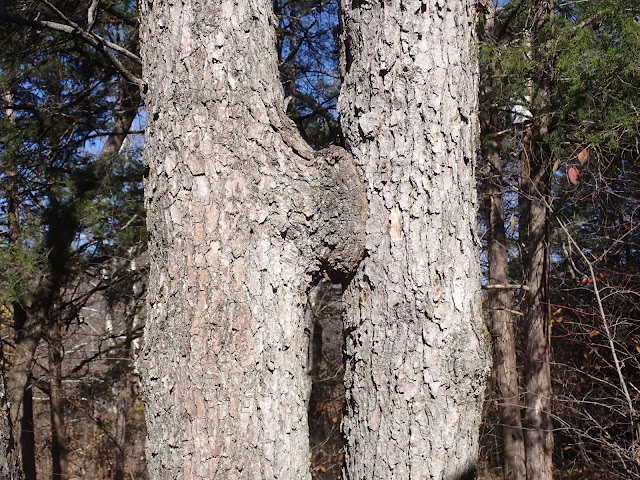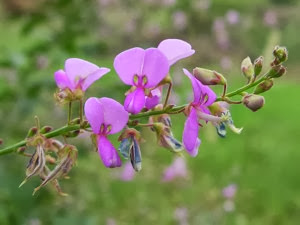
I have been intrigued for years with a pair of Shumard oak trees outside our kitchen window at the creek. Not only are they fused for 3 feet at the base, but they join together at eight and again at twelve feet above ground. I finally got around to looking into this.
This phenomena is called inosculation ("to unite intimately") and it is not unlike grafting in skin grafting in medicine when we sew on a skin flap and give it time to form new blood vessels before cutting its connection to the original source. The difference is this is a tree and it is the cambium that is connecting,
 |
| Click to enlarge - NYGB |
A little review for both of us. Beneath the dry outer bark there is a vascular layer of phloem transporting nutrients down to the roots like veins. Immediately inside that is the cambium and then the phloem which pumps up water and nutrients from the roots and also helps to form the woody element in the stem. (Think arteries.) Cambium is the layer of actively dividing cells between xylem (wood) and phloem (bast) tissues that is responsible for the secondary growth of stems and roots, i.e. growth occurring after the first season that results in increase in thickness of the stem or trunk.
It is most common for branches of two trees of the same species to grow together, though inosculation may be noted across related species. The branches first grow separately in proximity to each other until they touch. At this point, the bark on the touching surfaces is gradually abraded away as the trees move in the wind. Once the cambium of two trees touches, they sometimes self-graft and grow together as they expand in diameter." Inosculation-Wikipedia
Once this has occurred, bark also joins together, completing the healing and a solid junction. I can think of three examples in our valley alone.
 |
| Tree shaping - Axel Erlandson |
 |
| John Wesley tree |
Inosculation has also been used as an art form, binding branches to create a living sculpture. The famous John Wesley tree in Ireland was created by unknown means when two beech saplings were twisted at their crowns and they grew together over the years. In California Axel Erlandson* turned this into an innovative art form and a roadside attraction, binding branches of a tree, or trees, to form structures like the chair on the right.

A similar process leads to trees growing around other objects. At our cemetery we have a 26" diameter oak which had barbwire stapled to it in its youth. It gradually worked under the bark and the cambium grew wood around it as the girth of the little tree expanded. The wires are now sticking right through the center of the trunk.*
 I thought that was pretty amazing until I saw the Bicycle Tree. On Washington state's Vashon Island there is a tree which attracts a lot of tourists. A bicycle hung there years ago has slowly been incorporated into the tree. A legend of a young man leaving it leaning against a tree and going off to war is punctured by Snopes, but either way it is a remarkable sight. I now set my phone alarm when I lean up against a tree to take a nap.
I thought that was pretty amazing until I saw the Bicycle Tree. On Washington state's Vashon Island there is a tree which attracts a lot of tourists. A bicycle hung there years ago has slowly been incorporated into the tree. A legend of a young man leaving it leaning against a tree and going off to war is punctured by Snopes, but either way it is a remarkable sight. I now set my phone alarm when I lean up against a tree to take a nap.
Marilyn Owen wrote us about our local Car in a Tree at McDaniel Lake, described in the NewsLeader.
"Also, up by McDaniel Lake, there is part of a car high up in a tree. It is in my Christmas Bird Count area so I have always been interested in it and last year there was an article about it in the News Leader. It is believed to have come from a Ford Model A and has been there at least 70 years."
Andrew Jensen - Newsleader
* On a final note of irony, Wikipedia says the Barb wire is sometimes called Bob wire.
More on Axel Erlandson and views of his other inosculation creations is at this link


























